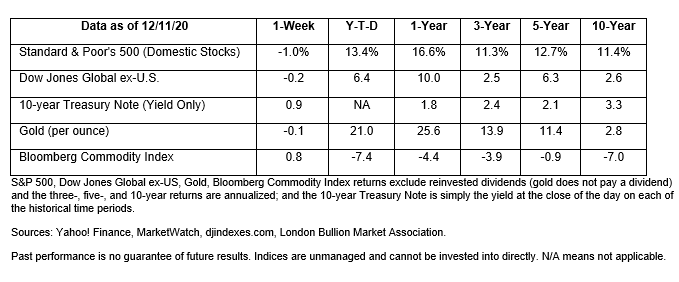Market Insight September 28, 2020
JOBLESS RECOVERY? Claims have come down but have completely stalled at current levels for 8 consecutive weeks. Typically, Jobless benefits last 26...

When it comes to beverages, frothy can be delicious.
In what may be the least inspiring description of fizzy drinks ever written, a group of food engineers explained, “Aeration in beverages, which is manifested as foam or bubbles, increases the sensory preference among consumers.”
Stock markets can fizz up, too. Share prices bubble, enthusiastic investors invest, and prices go even higher. In a frothy market, share prices often rise above estimates of underlying value. The terms that describe this financial market phenomenon include irrational exuberance, animal spirits, and overconfidence.
Last week, there was speculation about whether some parts of the U.S. stock market have gotten frothy. Eric Platt, David Carnevali, and Michael Mackenzie of Financial Times wrote about an initial public offering (IPO) of stock by a hospitality company. They reported:
“…[the share price] more than doubled in value on Thursday in a return to the kind of mammoth pops that came to define the dot-com boom of the late 1990s…It’s a sign of frothiness, a sign of incredible demand, a sign of a retail investor that…just wants to get in.”
That observation about investor enthusiasm for stocks was supported by the AAIISentiment Survey. Last week, 48.1 percent of participants were bullish. The long-term average is 38 percent. (Some believe the survey is a contrarian indicator. When bullishness is stronger than usual, contrarian investors would adopt a bearish stance, and vice versa.)
Despite IPO fervor, major U.S. stock indices finished lower last week. The decline has been attributed to a lack of new stimulus from Congress rather than concerns about high share prices. Inflation worries may have played a role, too. Last week, headlines in both The Economist and The Wall Street Journal suggested the post-pandemic world may include higher inflation.
Wall Street’s fear gauge, the CBOE Volatility Index edged higher last week, reported Ben Levisohn of Barron’s. It’s at about 24.6, which is above its long-term average of 1


The coronavirus, which The Economist estimates have infected one-in-five Americans, is reshaping holiday traditions this year. “COVID-19 is playing on shoppers’ psyches as they weigh its impact on their health and finances. But, as we’ve seen with previous periods of recession, as well as those of growth, consumers are resilient and will adjust their habits to adapt,” reported Deloitte’s 2020 holiday retail sales consumer survey report:
The Deloitte survey identified four types of holiday shoppers:
Do you recognize yourself in any of these descriptions?
“Beware the investment activity that produces applause; the great moves are usually greeted by yawns.”
--Warren Buffett, Investor
Best regards,
Niels Buksik
P.S. Please feel free to forward this commentary to family, friends, or colleagues. If you would like us to add them to the list, please reply to this email with their email address and we will ask for their permission to be added.
__________
* These views are those of ANCHORY LLC, and not the presenting Representative or the Representative’s Broker/Dealer, and should not be construed as investment advice.
*This newsletter was prepared by ANCHORY LLC.
*Government bonds and Treasury Bills are guaranteed by the U.S. government as to the timely payment of principal and interest and, if held to maturity, offer a fixed rate of return and fixed principal value. However, the value of fund shares is not guaranteed and will fluctuate.
*Corporate bonds are considered higher risk than government bonds but normally offer a higher yield and are subject to market, interest rate, and credit risk as well as additional risks based on the quality of issuer coupon rate, price, yield, maturity, and redemption features.
*The Standard & Poor's 500 (S&P 500) is an unmanaged group of securities considered to be representative of the stock market in general. You cannot invest directly in this index.
*All indexes referenced are unmanaged. The volatility of indexes could be materially different from that of a client’s portfolio. Unmanaged index returns do not reflect fees, expenses, or sales charges. Index performance is not indicative of the performance of any investment. You cannot invest directly in an index.
*The Dow Jones Global ex-U.S. The index covers approximately 95% of the market capitalization of the 45 developed and emerging countries included in the Index.
*The 10-year Treasury Note represents debt owed by the United States Treasury to the public. Since the U.S. Government is seen as a risk-free borrower, investors use the 10-year Treasury Note as a benchmark for the long-term bond market.
*Gold represents the afternoon gold price as reported by the London Bullion Market Association. The gold price is set twice daily by the London Gold Fixing Company at 10:30 and 15:00 and is expressed in U.S. dollars per fine troy ounce.
*The Bloomberg Commodity Index is designed to be a highly liquid and diversified benchmark for the commodity futures market. The Index is composed of futures contracts on 19 physical commodities and was launched on July 14, 1998.
*The DJ Equity All REIT Total Return Index measures the total return performance of the equity subcategory of the Real Estate Investment Trust (REIT) industry as calculated by Dow Jones.
*The Dow Jones Industrial Average (DJIA), commonly known as “The Dow,” is an index representing 30 stock of companies maintained and reviewed by the editors of The Wall Street Journal.
*The NASDAQ Composite is an unmanaged index of securities traded on the NASDAQ system.
*International investing involves special risks such as currency fluctuation and political instability and may not be suitable for all investors. These risks are often heightened for investments in emerging markets.
*Yahoo! Finance is the source for any reference to the performance of an index between two specific periods.
*The risk of loss in trading commodities and futures can be substantial. You should therefore carefully consider whether such trading is suitable for you in light of your financial condition. A high degree of leverage is often obtainable in commodity trading and can work against you as well as for you. The use of leverage can lead to large losses as well as gains.
*Opinions expressed are subject to change without notice and are not intended as investment advice or to predict future performance.
*Economic forecasts set forth may not develop as predicted and there can be no guarantee that strategies promoted will be successful.
*Past performance does not guarantee future results. Investing involves risk, including loss of principal.
* The foregoing information has been obtained from sources considered to be reliable, but we do not guarantee it is accurate or complete.
*There is no guarantee a diversified portfolio will enhance overall returns or outperform a non-diversified portfolio. Diversification does not protect against market risk.
*Asset allocation does not ensure a profit or protect against a loss.
Sources:
https://www.bloomberg.com/news/articles/2020-10-24/pelosi-mnuchin-trade-blame-as-pre-election-stimulus-hopes-dim (or go to https://peakcontent.s3-us-west-2.amazonaws.com/+Peak+Commentary/10-26-20_Bloomberg-Pelosi_Mnuchin_Trade_Blame_as_Pre-Election_Stimulus_Hopes_Dim-Footnote_1.pdf)
https://www.cnbc.com/2020/10/22/stock-market-futures-open-to-close-news.html
https://www.barrons.com/articles/global-equities-are-rising-stimulus-talks-are-all-that-matters-51603447358?mod=hp_LEAD_1_B_1 (or go to https://peakcontent.s3-us-west-2.amazonaws.com/+Peak+Commentary/10-26-20_Barrons-Stocks_End_Week_with_Losses_Snapping_Three-Week_Winning_Streak-Footnote_3.pdf)
https://www.barrons.com/articles/3-3-million-receiving-pandemic-unemployment-benefits-51603443601 (or go to https://peakcontent.s3-us-west-2.amazonaws.com/+Peak+Commentary/10-26-20_Barrons-3.3_Million_Receiving_Pandemic_Unemployment_Benefits_and_Two_More_Numbers_to_Know-Footnote_4.pdf)
https://insight.factset.com/sp-500-earnings-season-update-october-23-2020

JOBLESS RECOVERY? Claims have come down but have completely stalled at current levels for 8 consecutive weeks. Typically, Jobless benefits last 26...

Pay close attention and Adapt! There are legions of derisive headlines about a rising stock market attracting "retail traders": What these Wall...

1 min read
The Markets COVID-19 strikes again. Coronavirus cases have been on the rise in Europe, climbing from about 700,000 new cases a week in September to...